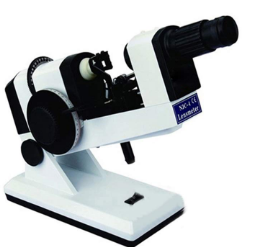In the realm of optometry, a focimeter is an indispensable tool used for precise measurement of lenses and assessing the visual needs of individuals. With its ability to determine lens power and diagnose refractive errors, the focimeter plays a pivotal role in providing accurate prescriptions for eyeglasses and contact lenses.
What is a Focimeter?
A focimeter, also known as a vertometer or lensometer is an optical instrument that measures the optical power of lenses, prisms and other optical devices. It is an essential device used by optometrists and opticians to ensure precise lens measurements and determine the necessary corrective measures for individuals with vision impairments.
The Importance of Accurate Lens Measurements
Accurate lens measurements are crucial for determining the refractive errors of patients and prescribing appropriate corrective lenses. Whether it’s nearsightedness (myopia), farsightedness (hyperopia), astigmatism or presbyopia, the focimeter enables eye care professionals to obtain accurate measurements ensuring optimal vision correction for their patients.

Parts of a Focimeter
A focimeter comprises several key parts that work together to provide accurate measurements of lenses. Following are its integral components:
1. Eyepiece
The eyepiece located at the top of the focimeter allows the user to observe the lens under examination. It often consists of an adjustable diopter to accommodate individual variations in visual acuity.
2. Target and Target Mask
The target positioned beneath the eyepiece is where the lens being tested is placed. It typically consists of a circular white background with various lines, dots and symbols to assist in aligning and measuring the lens.
The target mask is an adjustable component that covers the target helps eliminate unnecessary light and reflections ensuring precise measurements.
3. Lens Table
The lens table situated below the target provides a stable platform for the lens being measured. It includes adjustable arms and knobs to hold the lens securely in place during the measurement process.
4. Power Drum
The power drum is a vital part of the focimeter that allows for the measurement of lens power. By rotating the power drum, the user can accurately determine the refractive power of the lens in question.
5. Prism Compensator
Incorporated into some advanced focimeters the prism compensator aids in measuring the presence and strength of prisms in the lenses. It ensures accurate assessment and prescription for individuals with prism requirements.
6. Axis Wheel
The axis wheel, found on modern focimeters allows the user to measure the axis of astigmatism in the lens being examined. By aligning the appropriate markings on the wheel with the astigmatic axis precise measurements are obtained.
Functions of a Focimeter
The focimeter performs several essential functions that contribute to accurate lens measurement and prescription determination. Let’s explore the primary functions of this vital instrument:
1. Lens Power Measurement
The focimeter enables eye care professionals to measure the optical power of lenses precisely. By aligning the lens with the target the power drum is rotated until the target’s lines or dots are sharply focused. The reading on the power drum indicates the lens power expressed in diopters.
2. Detection of Prism Power
For individuals requiring prism correction the focimeter can accurately detect the presence and strength of prisms within the lenses. The prism compensator aids in this process allowing for precise measurement and prescription customization.
3. Determining Cylinder Axis
With its axis wheel feature the focimeter facilitates the measurement of the astigmatic axis in lenses. By aligning the markings on the wheel with the appropriate axis eye care professionals can accurately determine the cylindrical power required for astigmatism correction.
4. Verifying Lens Markings
The focimeter serves as a valuable tool for opticians to verify the accuracy of lens markings. By measuring the prescribed lens and comparing it to the marked power and axis any discrepancies can be identified and rectified ensuring patients receive the correct lenses.
5. Assessing Lens Quality
Apart from measuring lens power the focimeter allows eye care professionals to evaluate lens quality and identify any manufacturing defects. By observing the target’s reflection in the lens opticians can detect aberrations, scratches or imperfections that may affect visual clarity.
In conclusion, the focimeter stands as a crucial instrument in the field of optometry enabling eye care professionals to accurately measure lens power, diagnose refractive errors and prescribe appropriate corrective measures. With its various components including the eyepiece, target, lens table, power drum, prism compensator and axis wheel the focimeter offers comprehensive functionality for precise lens assessment. By understanding the intricacies of this essential tool, optometrists and opticians can enhance their ability to provide optimal vision correction and meet the visual needs of their patients effectively.






